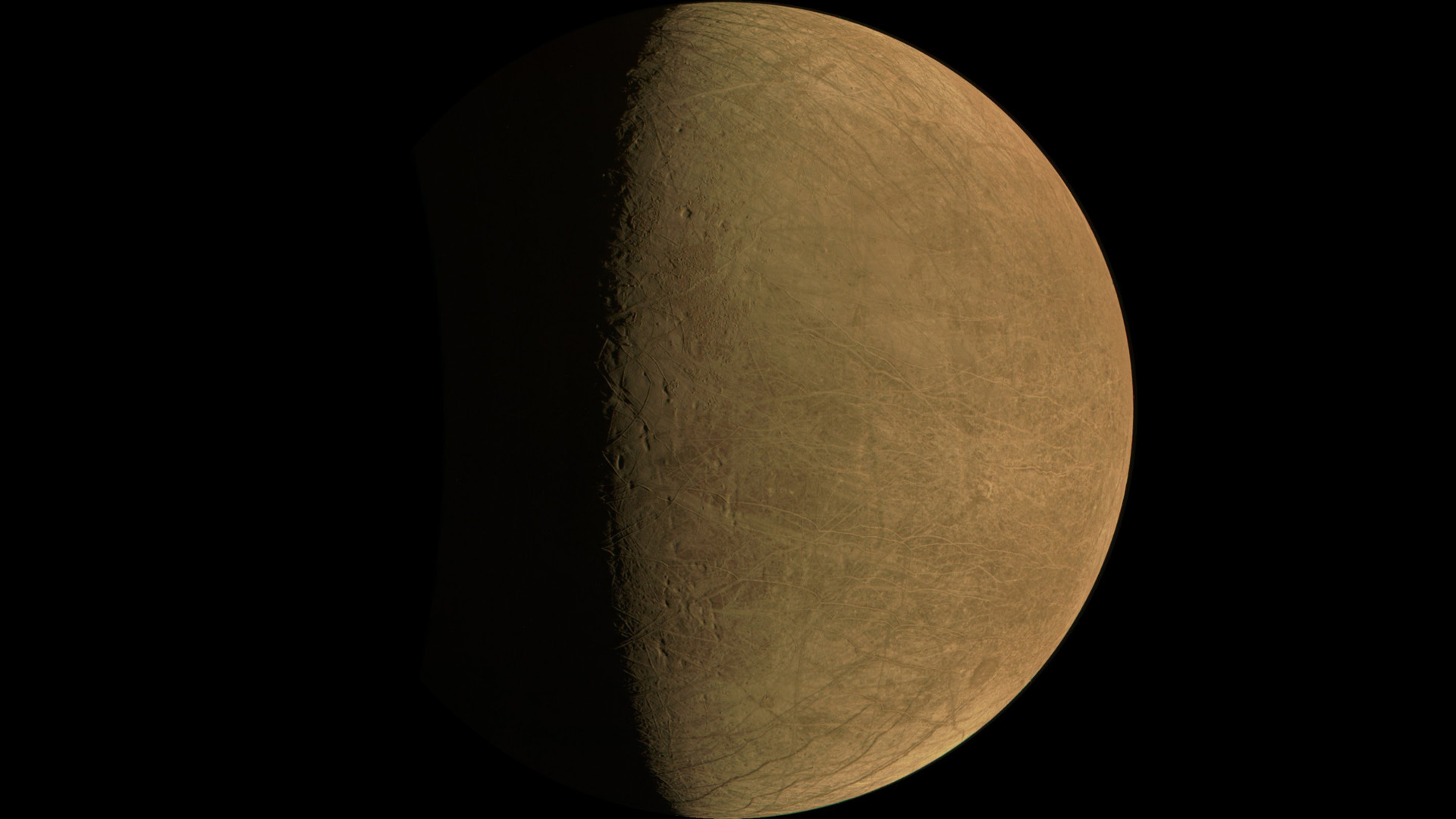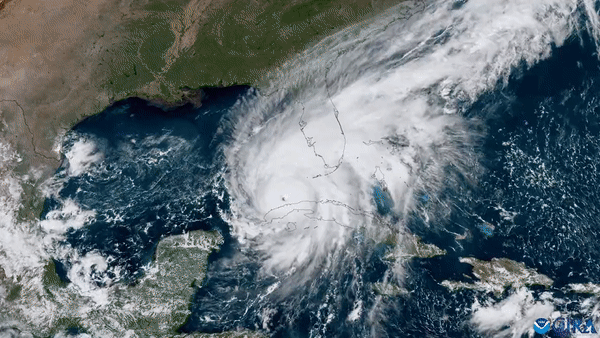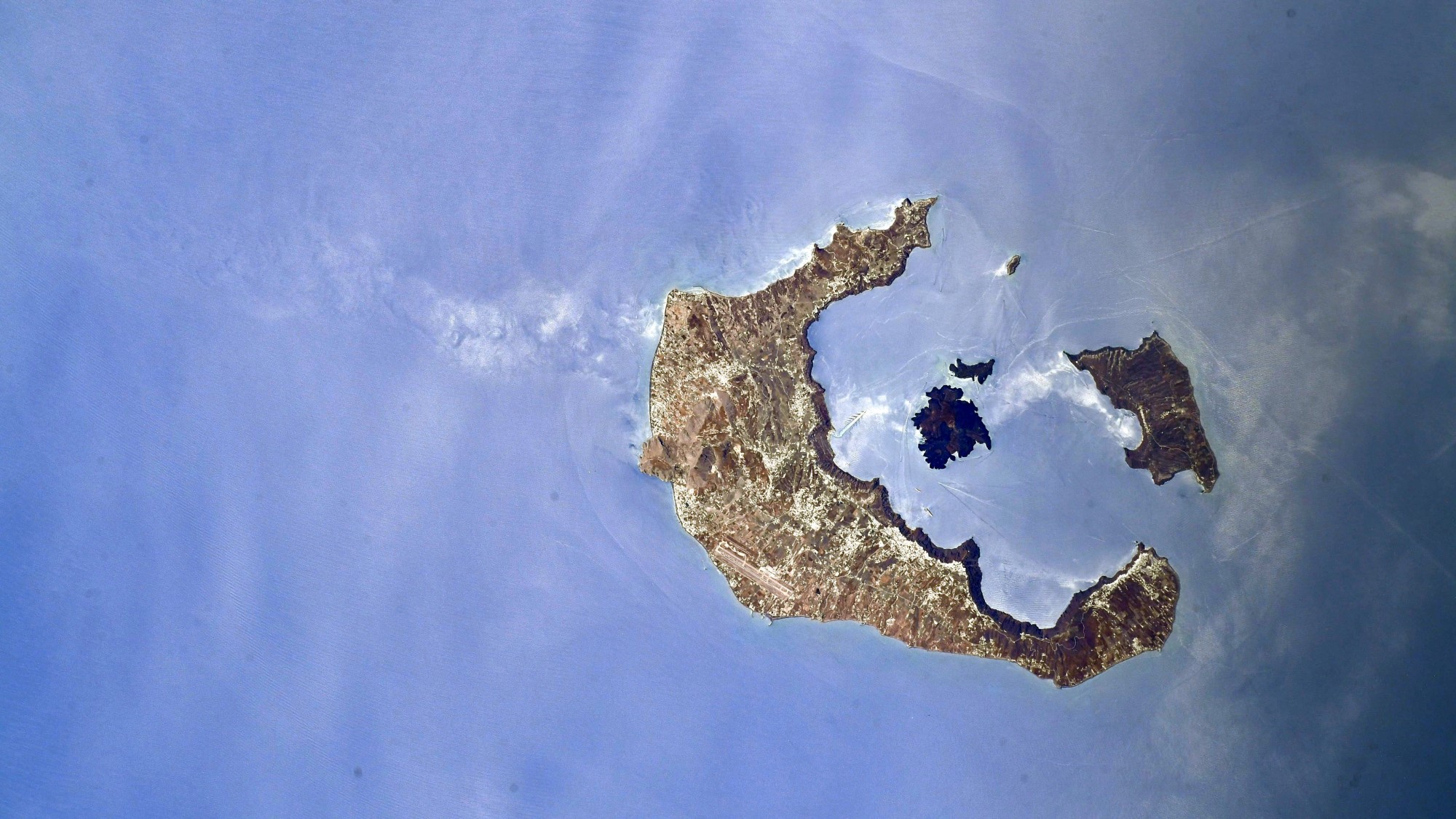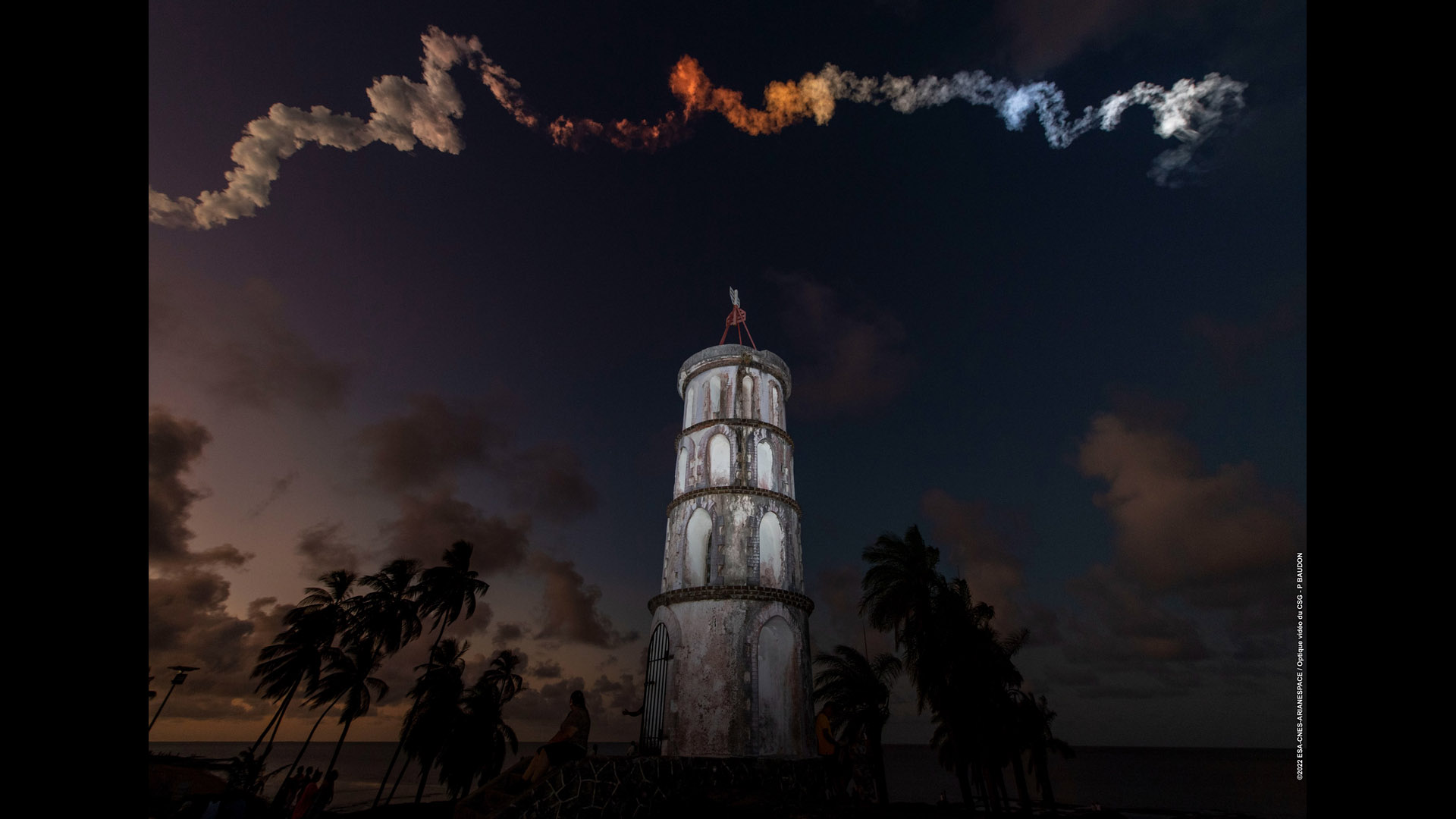September 2022
The closest views of Europa in more than 20 years

Friday, September 30, 2022: NASA's Jupiter explorer Juno has made a close flyby of the giant planet's ice-covered moon Europa, providing the most detailed views of this strange world in more than twenty years.
This image, taken as the probe approached the moon, was shared by NASA on Twitter on Thursday, September 29, shortly after the closest pass, which took place at 5:36 a.m. EDT (0936 GMT).
During the flyby, Juno zipped at a distance of only 219 miles (352 kilometers) from Europa's surface, the third closest pass at the moon performed by any spacecraft. The last time scientists could get such an up-close glimpse of Europa, which is one of the likeliest places in the solar system to harbor primitive life, was in January 2000 when NASA's Galileo probe zoomed 218 miles (351 km) above Europa's surface. –Tereza Pultarova
Lights off in Florida after hurricane Ian's rampage

Thursday, September 28, 2022: Satellites captured darkened Florida after devastating Hurricane Ian cut power to millions of homes.
The image on the left, taken on the night of Sept. 29 by the NOAA 20 satellite operated by the U.S. National Oceanic and Atmospheric Administration, reveals the scale of the power outages that hit Florida after Ian swept across the state on Wednesday afternoon and into the night. The comparison image on the right was taken four days earlier.
The storm made landfall as an extremely dangerous Category 4 hurricane on the southwestern coast near Tampa earlier on Wednesday, and although it weakened into a 'mere' tropical storm shortly thereafter, it caused wide reaching destruction that rescue teams are only beginning to assess.
Weather forecasters warn that Ian may strengthen again as it moves northward over South Carolina, bringing torrential rains and powerful winds. – Tereza Pultarova
Get the Space.com Newsletter
Breaking space news, the latest updates on rocket launches, skywatching events and more!
Hurricane Ian swirls over Gulf of Mexico ahead of Florida landfall

Wednesday, September 28, 2022: The strengthening Hurricane Ian swirls above the Gulf of Mexico in a video sequence taken by NOAA's GOES 16 satellite as it approaches Florida as a threatening Category 3 storm, forcing people to leave their homes to escape flooding and destructive winds.
Ian emerged over the Caribbean Sea over the weekend as a tropical storm and quickly grew into a hurricane before it reached Cuba on Tuesday (Sept. 27), unleashing heavy rains and sustained winds of 120 mph (192 km/h).
Ian, still gaining power over the warm waters of the Gulf of Mexico, will become a Category 4 hurricane before making landfall in Florida on Wednesday (Sept. 28) night. The storm is then expected to carve a path along the U.S. East coast, ripping through the southern states of Georgia and South Carolina. – Tereza Pultarova
Cubesat witness reveals DART asteroid impact

Tuesday, September 27, 2022: The Italian LICIACube cubesat, which traveled to the binary asteroid Didymos aboard NASA's asteroid-smashing DART mission, captured these images of DART's collision with its target space rock.
"Here are the first images taken by #LICIACube of #DARTmission impact on asteroid #Dimorphos," the LICIACube team tweeted on Tuesday (Sept. 27). "Now weeks and months of hard work are starting for scientists and technicians involved in this mission, so stay tuned because we will have a lot to tell!"
LICIACube is a 31-pound (14 kilograms) spacecraft whose sole purpose is to witness first-hand the impact and the direct aftermath of the ground-breaking DART mission. DART, for Double Asteroid Redirection Test, successfully self-destructed on Monday (Sept. 26), by slamming into the 525-foot-wide (160 m) asteroid moonlet Dimorphos in an attempt to change its orbit around the 2,560-foot-wide (780 m) parent space rock Didymos. The experiment will help NASA develop technology that could one day prevent a devastating asteroid strike on Earth. – Tereza Pultarova
Last photo of asteroid Didymos before DART impact

Monday, September 26, 2022: This may be the last picture of asteroid Didymos before its encounter with NASA's asteroid-smashing probe DART.
The dot of light in this image, captured by the Very Large Telescope (VLT) of the European Southern Observatory (ESO) in Chile on the night of September 25/26, is in fact two asteroids combined — Didymos and its smaller moonlet Dimorphos which will be the ultimate target of the collision with DART.
The VLT, one of the most powerful optical telescopes in the world, will play an important role in the observations of the DART impact aftermath. Astronomers hope the telescope will be able to provide data about the composition and motion of the material ejected from Dimorphos upon the DART crash, and make some measurements of the structure of the asteroid's surface and interior, ESO said in a statement. – Tereza Pultarova
Hubble Space Telescope observes a young exploding star

Friday, September 23, 2022: The Hubble Space Telescope has captured a star surrounded by a shroud of gas created by a recent explosion.
The star, called IRAS 05506+2414, is quite young and located some 9,000 light-years from Earth in the constellation Taurus. The clouds of swirling material that surround the star were stirred up by some sort of an explosion that disrupted the young star system, NASA said in a statement. The material in those clouds flows away from the star at mind-boggling speeds of 217 miles per second (350 km per second). Hubble took this image with its Wide Field Camera 3. – Tereza Pultarova
Hurricane Fiona grows into a Category 4 storm

Thursday, September 22, 2022: Hurricane Fiona, seen in this image from the European Sentinel 3 satellite, has grown into a mighty Category 4 hurricane, while it moved toward Bermuda which it is expected to skirt later today.
Fiona is the first major hurricane of the 2022 Atlantic season, which had an unusually slow start with no major storms forming above the Atlantic Ocean in the entire month of August for the first time in 25 years.
Fiona, which will stay at a safe distance from the U.S. east coast, unleashed torrential rains and powerful winds on Puerto Rico and the Dominican Republic earlier this week, causing widespread power blackouts. The hurricane will make landfall on the eastern coast of Canada this weekend as a category 2 hurricane. – Tereza Pultarova
Webb captures distant Neptune in a galaxy-studded sky

Wednesday, September 21, 2022: The James Webb Space telescope captured the solar system's most distant planet Neptune on the backdrop of a galaxy-studded sky.
The ice giant is hard to image and hasn't been observed with such clarity since the flyby of NASA's deep space mission Voyager in 1989. The planet, more than 2.7 billion miles (4.3 billion kilometers) away from Earth, is the closest object in the image, seen on the backdrop of galaxies that are billions of light-years away. – Tereza Pultarova
A striking image

Tuesday, September 20, 2022: On Sept. 12, lightning came quite close to the Artemis 1 rocket out on the launch pad at NASA's Kennedy Space Center in Florida. But the lightning didn't come from a bright blue sky, of course. This image combines NASA's footage of the strike with a "clear day frame" filter that substitutes the stormy sky with a view of the rocket under calmer weather. -Meghan Bartels
A glimpse of Greece

Monday, September 19, 2022: European astronaut Samantha Cristoforetti shared an image of Greece's Santorini island as seen from space. "Greece is the birthplace of countless myths, of philosophy, democracy & the Olympic Games!" she wrote in a tweet accompanying a dozen different images of the nation, including mainland locations like Thessaloniki, "enchanting islands" like Samothrace, and a night view of the capital city of Athens.
"I love the intricate patterns of Greece’ coastlines, the tongues of land protruding into the seas, the cities nested in the bays, like Thessaloniki," she wrote in another tweet. -Meghan Bartels
The 'Queen's' queue seen from space

Friday, September 16, 2022: The vast amount of people queuing in central London to see the coffin of the deceased British monarch, Queen Elizabeth II, can be seen in this image taken on Friday (Sept. 16) by satellites of the U.S. Earth observation firm Maxar Technologies.
The image shows the Westminster Bridge over the river Thames and the area around the iconic Houses of Parliament, where the Queen is lying in state.
According to media reports, the queue reached a length of over 5 miles (8 kilometers) on Friday afternoon, and new arrivals are currently not allowed to join. The mourners have to wait for more than 12 hours to see the Queen's coffin at Westminster Hall, which will be open round the clock until Monday morning. – Tereza Pultarova
Ancient stones emerge amid punishing drought in Spain

Thursday, September 15, 2022: An ancient monument dubbed the Spanish Stonehenge has emerged from an artificial lake for only the fourth time since the 1960s as a historic drought drained water from the reservoir.
This image of the 5,000-year-old Dolmen of Guadalperal stone circle under the stunning band of the Milky Way adorning the night sky was captured by Portuguese astrophotographer Sérgio Conceição after water levels in the the Valdecañas reservoir in the Extremadura region in western Spain dropped to only 28% of the capacity in July this year.
Conceição told Space.com that it took six hours to reach the monument for the night time shoot via a foot trail, carrying all his photographic equipment.
The monument, consisting of 150 upright granite stones, emerged amid the worst drought on the Iberian Peninsula in 1,200 years, according to Reuters. – Tereza Pultarova
Hubble sees galaxy with massive black hole at its center

Wednesday, September 14, 2022: With the attention of the world's space aficionados fixed on the endless stream of mind-blowing images beamed to Earth by the James Webb Space Telescope, the older Hubble Space Telescope might feel a little forgotten. But the 32-year-old astronomy workhorse reminds us all that it still has it, most recently with this new image of a spiral galaxy some 189 million light-years away.
The galaxy in the image is called NGC 1961, and astronomers think it has a very active super massive black hole at its center that constantly spouts highly energetic beams of material into the intergalactic space.
NGC 1961, located in the constellation Camelopardalis (near Ursa Minor), is a little less complex than our galaxy, the Milky Way, as its center doesn't feature a prominent bar of thickly packed stars, gas and dust. – Tereza Pultarova
Full moon rises above ancient castle

Tuesday, September 13, 2022: The harvest moon of 2022 rises above an ancient Portugal castle on the evening of September 10 in this image taken by a local astrophotographer.
The harvest moon, as the September full moon is called, shines bright above the Terena Castle, in the municipality of Alandroal in central Portugal, which dates back to the 13 century.
The image was captured at 10:26 p.m. local by astrophotographer Sérgio Conceição using a Canon EOS R camera with a 300mm lens. – Tereza Pultarova
Wildfires in American West seen from space

Monday, September 12, 2022: Wildfires raging on the North American west coast have been spotted by the European Earth-observing satellite Sentinel-3 this weekend.
Massive plumes of smoke rise from multiple regions where fires have erupted in the past days. In the states of Oregon and Washington, 390 square miles (1,000 square kilometers) of land have burnt so far and thousands of residents had to be evacuated. The Cedar Creek Fire, one of the largest in the region, can be seen in the image on the right. – Tereza Pultarova
Trails of Starlink satellites spoil observations of a distant star

Friday, September 9, 2022: Trails of SpaceX's Starlink satellites spoil this image of the star Albireo some 434 light-years from Earth as astronomers caution the growing number of low-Earth-orbit satellites will make observations more difficult.
The image, captured by astronomer Rafael Schmall, was released by the European Southern Observatory on Twitter on Friday, Sept. 9. The observatory, which operates some of the largest telescopes in the world, has recently released a new report, which looks at the impact of mega-constellations such as Starlink on astronomical research.
ESO says wide-field surveys (such as ESO's Visible and Infrared Survey Telescope for Astronomy, VISTA, in Chile) will experience the worst effects. Up to 50% of twilight observations made by these survey telescopes can be impacted by unwanted satellite trails, ESO said. – Tereza Pultarova
Smoke trails in the wake of Ariane 5's record-breaking launch

Thursday, September 8, 2022: This image shows a trail of smoke left behind by the European Ariane 5 rocket after its launch from the European Spaceport in Kourou, French Guiana, on Wednesday (Sept. 7).
Ariane 5, Europe's reliable heavy-lift workhorse booster, blasted off from Kourou on Wednesday at 5:45 p.m. EDT (2145 GMT) into the dusk sky, painting colorful trails above the tropical landscape.
The launch, only the second for Ariane 5 this year, lofted into the geostationary transfer orbit the Eutelsat Konnect VHTS telecommunication satellite, which, with a mass of 7 tons (6.4 metric tons) and a length of 29 feet (8.8 m), is the largest ever telecommunications satellite launched by Ariane 5.
According to the launch operator Arianespace, Ariane 5, first flown successfully in 1998, only has three more launches to go before retiring. The rocket will be replaced by the newer, but considerably delayed Ariane 6. – Tereza Pultarova
Satellites capture sunken bulk carrier in Gibraltar bay

Wednesday, September 7, 2022: A European Earth-observing satellite captured this image of a partially sunken bulk carrier that collided off the coast of Gibraltar with a gas tanker last week.
The accident, which took place on Tuesday August 30, caused a leak of fuel from the damaged bulk carrier and forced the local port to close. Fuel had to be removed from the carrier before rescue operations could commence. The carrier is still stranded in the sea more than a week later. This image was taken by the Copernicus Sentinel-2 satellites on Monday (Sept. 5) – Tereza Pultarova
Michigan-based photographer captures stunning images of STEVE

Tuesday, September 6, 2022: Michigan-based photographer Isaac Diener captured this stunning image of the Strong Thermal Emission Velocity Enhancement (STEVE), an unusual form of aurora borealis, on September 5 on the Keweenaw Peninsula in Upper Michigan.
Diener, who has been photographing auroras for about seven years, said this was only the second time he had seen STEVE "that defined overhead."
"You can't predict when it's gonna happen," Diener told Space.com in an email. "It appears out of nowhere."
He added he used the same equipment and settings for his shots of STEVE as he uses to take images of the more common aurora borealis.
"I use a Fujifilm XT-3. And the lens I use is a 16mm lens," Diener said. "Settings I used on those STEVE pics are Aperture 1.4, 12 seconds, ISO 800." – Tereza Pultarova
First hurricane of this year's Atlantic season seen from space

Monday, September 5, 2022: The European Earth-observing satellite Sentinel 3 photographed hurricane Danielle, which formed in the Atlantic Ocean after an unusually quiet period.
For the first time in 25 years, no tropical storm arose from the Atlantic Ocean in the month of August, according to the U.S. National Oceanic and Atmospheric Administration (NOAA). Danielle, which broke the quiet spell when it formed from moisture above the central Atlantic on Thursday (Sept. 1), is not threatening the U.S. coast as Atlantic hurricanes usually do, but is instead tracking eastwards toward Europe.
AccuWeather predicts that Danielle, currently a category 1 hurricane will weaken and disintegrate before reaching the south of the U.K. and the western coast of France this weekend. Sentinel 3 took this image on Sunday (Sept. 4). – Tereza Pultarova
Artemis 1 ready for the second go

Friday, September 2, 2022: NASA's Space Launch System rocket waiting on the launchpad at NASA's Kennedy Space Center in Florida ahead of its second attempt to lift off for its debut moon trip.
The rocket's first launch attempt was scrubbed shortly before lift-off on Monday (Aug. 29) due to an engine cooling issue. The launch is now scheduled to take place on Saturday (Sept. 3) at 2:17 p.m. EDT (1817 GMT). The rocket will send the uncrewed Orion space capsule for a 42-day-long trip to the moon and back to test critical technologies before a mission with astronauts can take place in 2024. – Tereza Pultarova
Monster Typhoon Hinnamnor threatens Japan

Thursday, September 1, 2022: A mega-typhoon that formed in the Eastern Pacific Ocean brings destructive winds and flooding into southern Japan and South Korea.
The typhoon, named Hinnamnor, is the most powerful tropical storm of the 2022 typhoon season. In this image, taken by the European Earth-observing satellite Sentinel 3 on Wednesday (Aug. 31), the typhoon covers a large portion of the 745-mile-wide (1,200 kilometers) shot.
Forecasters predict wind gusts of up to 185 mph (300 km/h), threatening widespread damage to infrastructure, according to AccuWeather.
The northern summer of 2022 has been full of extremes with record drought and heat waves plaguing most of Europe and extreme floods ripping through Pakistan and parts of the U.S. The Atlantic hurricane season, on the other hand, has been extremely quiet, producing no hurricanes in the month of August, a first in 25 years, according to Bloomberg.-- Tereza Pultarova
Can't find the date you're looking for? It may have been a weekend or holiday, when we don't normally update our Image of the Day.
Click 'NEXT PAGE' below for October >
Join our Space Forums to keep talking space on the latest missions, night sky and more! And if you have a news tip, correction or comment, let us know at: community@space.com.

Space.com is the premier source of space exploration, innovation and astronomy news, chronicling (and celebrating) humanity's ongoing expansion across the final frontier. Originally founded in 1999, Space.com is, and always has been, the passion of writers and editors who are space fans and also trained journalists. Our current news team consists of Editor-in-Chief Tariq Malik; Editor Hanneke Weitering, Senior Space Writer Mike Wall; Senior Writer Meghan Bartels; Senior Writer Chelsea Gohd, Senior Writer Tereza Pultarova and Staff Writer Alexander Cox, focusing on e-commerce. Senior Producer Steve Spaleta oversees our space videos, with Diana Whitcroft as our Social Media Editor.
